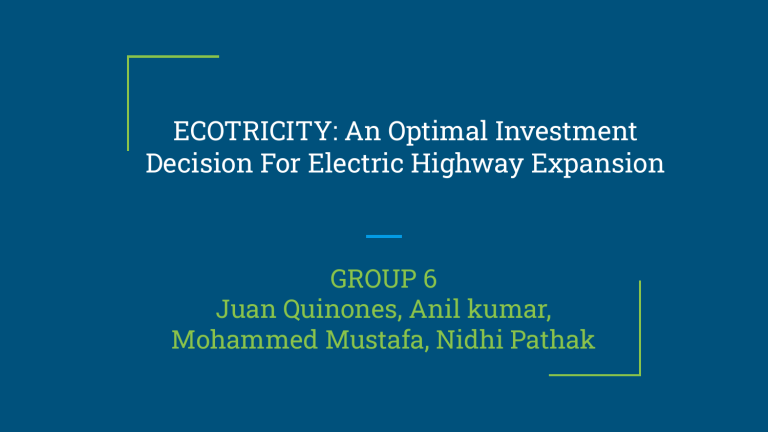
ECOTRICITY: An Optimal Investment Decision For Electric Highway Expansion GROUP 6 Juan Quinones, Anil kumar, Mohammed Mustafa, Nidhi Pathak Introduction Ecotricity, founded by Dale Vince in 1995, aims to fight climate change through renewable energy. The company has established a network of rapid-changing stations across major highways in the UK and seeks to expand this network. As of July 2016, the company had 300 rapid charging stations throughout the United Kingdom. - Background - - Founder: Dale, Vince, started the energy company to promote wind power. In 2010 the company ventured into green gas, making it a full-fledged energy company. Growth: From its first windmill in 1996 to 70.7 megawatts of installed capacity and 176,607 homes served by February 2016. Revenue: £109.8 million in FY 2014-15 Awards: Received multiple awards for sustainability efforts. - General Mission and Vision for 2030 - Mission: To transform electricity generation in Britain, focusing on green energy, excellent customer service, and ethical pricing. Green Britain: Ecotricity’s vision includes Britain being fully powered by renewable energy and half of the vehicles on the road being electric by 2030. - - Battery-Charging Network - Ecotricity launched its Electric highway in 2014, a network of battery-charging ports for EV’s. On-average the electric highway network delivered 5 million miles of emission-free clean electricity for EV customers. The network includes rapid chargers in public roads and private homes of willing customers. - 3 broad classifications of EV charging devices. Slow, fast, and rapid 6-8 hours, 3-4 hours, and 30 minutes for an 80% charge respectively. Additionally, charging ports can be located in public stations(Type A) or private locations (Type B). Type A chargers are costlier to Ecotricity, however Type B chargers are limited in waiting area and parking space. EV Chargers - - - - Competitive Landscape - Competitors include Chargemaster, Charge Your Car, and Tesla, each with different business models and charging network approaches. Ecotricity’s unique position is that it reinvests profits into its mission rather than issuing dividends (private company). Volume and Growth Projections for Electric Vehicles - - - Based on a study conducted by Ecotricity, by 2030 it would be cheaper to run an EV than a petrol vehicle by a difference of £1,000 Ecotricity estimated the number of EV’s in the UK would be 5 million by 2030. Ecotricity predicts traffic flow in 2030 will be all electric and five times the current EV traffic - Expansion Plan - - Ecotricity’s strategy could assume that the traffic flow in 2030 would be all electric and five times the current EV traffic in each highway segment. It announced a £70 million renegotiating bargain for realizing the company’s vision moving forward. Ecotricity wants to grow the number of charging points in the region of the M4, M5, and M40 highways - Business Problem - Grow the number of charging points along the M4, M5 and M40 highways. Focus on key motorways and service stations to meet increased demand with efficiency. Optimally distributing Type A ( Public Charging points) and Type B (Private charging points) between three highways. Conceptual Decision Variables Decision Variables - Number of Chargers for each locations Type A ( 5 decision variables) - Number of Chargers for each locations Type B ( 5 decision variables) Conceptual Constraints and Objective Function Constraints - Demand Constraints: The new additional stations should have sufficient chargers to meet demand for EV charging. - Geographical Constraints: Chargers need to be distributed across different highway segments to ensure coverage in each segment. Additionally each segment has a limit of available locations for new charging ports - Capacity Constraints: Each charging station has a maximum capacity it can handle without causing significant delays. Objective Function - Minimize the installation cost incurred.


